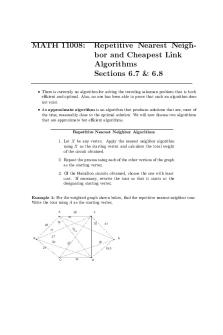Brute-Force And Nearest Neighbor Algorithms PDF

| Title | Brute-Force And Nearest Neighbor Algorithms |
|---|---|
| Course | Explorations In Modern Mathematics |
| Institution | Kent State University |
| Pages | 4 |
| File Size | 110.1 KB |
| File Type | |
| Total Downloads | 91 |
| Total Views | 134 |
Summary
Explanation and Practice Examples about Brute-Force and Nearest
Neighbor Algorithms....
Description
MATH 11008:
Brute-Force and Nearest Neighbor Algorithms Section 6.5
• Traveling Salesman Problem: Any problem that has a traveler, a set of sites, a cost function for travel between sites (weights on the edges), and need to tour all the sites (Hamilton circuit), and a desire to minimize the total cost of the tour (Hamilton circuit of least total weight) is known as a traveling salesman problem (TSP). • total weight of a circuit: The total weight of a circuit is the sum of the weights on the edges of the circuit. • Minimum Hamilton circuit: In a weighted graph, a minimum Hamilton circuit is a Hamilton circuit with smallest possible total weight.
Brute Force Algorithm: 1. Make a list of all the possible Hamilton circuits of the graph. Each of these circuits represents a tour of the vertices of the graph. 2. For each tour calculate its weight. 3. Choose a Hamilton circuit with smallest total weight. (There is always more than one optimal tour to choose from.)
◦ The Brute Force Algorithm is an example of an optimal algorithm because when implemented correctly it is guaranteed to produce an optimal solution. ◦ The Brute Force Algorithm is also an example of an inefficient algorithm because the number of steps needed to carry it out grows disproportionately with the number of vertices in the graph.
MATH 11008: BRUTE-FORCE AND NEAREST NEIGHBOR ALGORITHMS SECTION 6.5
2
Example 1: Find a minimum Hamilton circuit for the complete, weighted graph shown below:
B
C
3 1
4 6
1
F
3
E
MATH 11008: BRUTE-FORCE AND NEAREST NEIGHBOR ALGORITHMS SECTION 6.5
3
Nearest Neighbor Algorithm: 1. Start at the designated starting vertex. If there is no designated starting vertex pick any vertex. 2. From the starting vertex go to its nearest neighbor (the vertex for which the corresponding edge has the smallest weight). 3. From each vertex go to its nearest neighbor, choosing only among the vertices that haven’t been yet visited. (If there is more than one nearest neighbor choose among them at random.) Keep doing this until all the vertices have been visited. 4. From the last vertex return to the starting vertex.
◦ The Nearest Neighbor Algorithm is also an example of an efficient algorithm because the amount of computational effort required to implement the algorithm grows in some reasonably proportion with the size of the input to the problem. ◦ Unfortunately, the Nearest Neighbor Algorithm is NOT an example of an optimal algorithm since it does not always find the optimal solution.
Example 2: A courier is based at the head office (labeled A) and must deliver documents to four other offices (labeled B, C, D, E). The estimated travel time between each of these offices is shown on the graph below. The courier wants to visit the locations in an order that takes the least time. Use the nearest neighbor algorithm to find an approximate solution to this problem. Calculate the time required to cover the chosen route.
B 10
9
C
13 9
A
20
8 7 8
3 E
5
D
MATH 11008: BRUTE-FORCE AND NEAREST NEIGHBOR ALGORITHMS SECTION 6.5
4
Example 3: For the weighted graph shown below, find the indicated tour and give its cost. A
40
80
30 D
60
C
20 B 25
(a) Use the Brute Force Algorithm to find an optimal tour.
(b) Use the nearest-neighbor algorithm with starting vertex A.
(c) Use the nearest-neighbor algorithm with starting vertex C .
(d) Use the nearest-neighbor algorithm with starting vertex D....
Similar Free PDFs

A. Klasifikasi K-Nearest Neighbor
- 43 Pages

Data structures and algorithms
- 18 Pages

Algorithms and Data Structures
- 5 Pages

Data Structure and Algorithms
- 126 Pages

Sorting and Searching Algorithms
- 36 Pages

The neighbor principle
- 1 Pages

Analysis and Design of Algorithms
- 31 Pages

Algorithms and Data Structures Notes
- 36 Pages

MAKALAH KNN (K-NEAREST NEIGHBOUR)
- 10 Pages
Popular Institutions
- Tinajero National High School - Annex
- Politeknik Caltex Riau
- Yokohama City University
- SGT University
- University of Al-Qadisiyah
- Divine Word College of Vigan
- Techniek College Rotterdam
- Universidade de Santiago
- Universiti Teknologi MARA Cawangan Johor Kampus Pasir Gudang
- Poltekkes Kemenkes Yogyakarta
- Baguio City National High School
- Colegio san marcos
- preparatoria uno
- Centro de Bachillerato Tecnológico Industrial y de Servicios No. 107
- Dalian Maritime University
- Quang Trung Secondary School
- Colegio Tecnológico en Informática
- Corporación Regional de Educación Superior
- Grupo CEDVA
- Dar Al Uloom University
- Centro de Estudios Preuniversitarios de la Universidad Nacional de Ingeniería
- 上智大学
- Aakash International School, Nuna Majara
- San Felipe Neri Catholic School
- Kang Chiao International School - New Taipei City
- Misamis Occidental National High School
- Institución Educativa Escuela Normal Juan Ladrilleros
- Kolehiyo ng Pantukan
- Batanes State College
- Instituto Continental
- Sekolah Menengah Kejuruan Kesehatan Kaltara (Tarakan)
- Colegio de La Inmaculada Concepcion - Cebu






